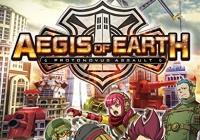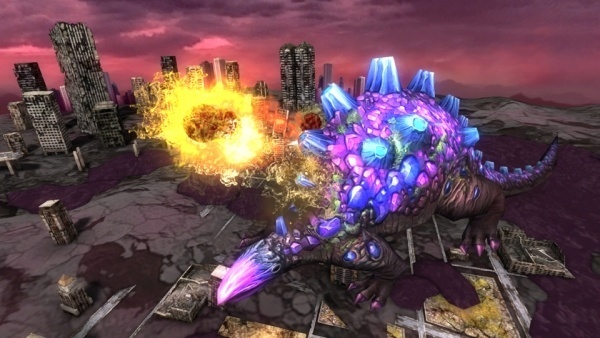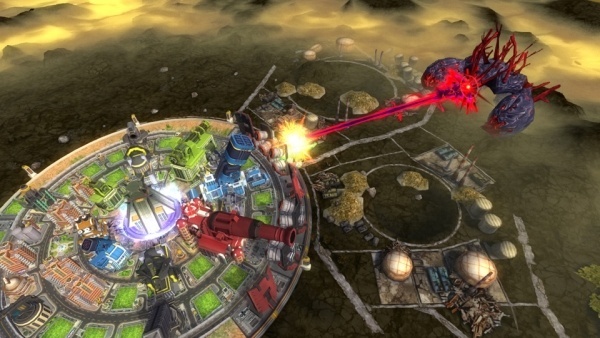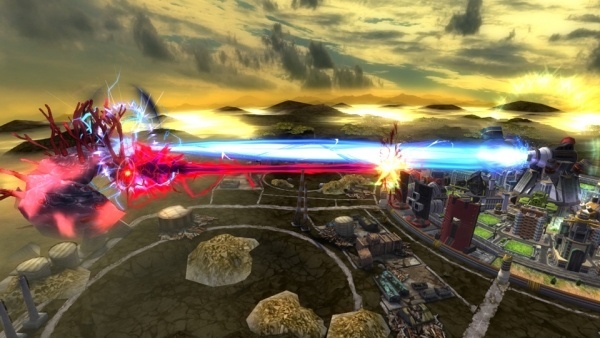Aegis of Earth: Protonovus Assault (PlayStation 4) Second Opinion Review
By Josh Di Falco  31.07.2016
31.07.2016

Aegis of Earth: Protonovus Assault is a unique title with an interesting gameplay idea. Developed by the company that created the Tenchu series, Acquire's latest title creates a good blend of JRPG with a real-time tower defence game, providing many hours of entertainment. With various cities to build up and defend from the invading monsters, with a plethora of different towers and a colourful cast of anime-inspired characters, can this newest iteration of a tower defence game stand tall?
The story is simple enough to understand, with humanity attempting to recover from the "Silent Apocalypse," which was a near-catastrophic event that brought the world to ruins, and left the remaining nations to scramble to fortified towns. Upon discovering a new mineral source called altenite, cities were erected upon the lands that were rich in the mineral. However, the minerals also attract the monsters and as such, this serves as the explanation as to why the cities are constantly under attack. The cities are designed in a way to defend against these horrors, which is the basis for the gameplay.
The cities contain four rotatable rings, which revolve independently of each other. The inner three rings have a set amount of land tiles on it, which the defensive towers are built upon, while the fourth ring allows temporary barriers to be developed, acting as a shield to protect the city. Then as the enemies march on towards the city, the rings can rotate in order to align the towers with the oncoming enemies in order to destroy them.

Upon completing the number of enemy waves in the battle, the city enters production mode, where further towers can be created or upgraded. After every successful battle, civilians migrate to the town from the horrors that are befalling the rest of the world. These civilians are the catalyst for the tower defence style, because the aim is to protect them from the monsters. By keeping the civilians alive, they pay tax to continue living there, thus allowing more money to be generated in order to then achieve further upgrades. However, if the city takes heavy damage or a residential building is razed in the onslaught, civilians will perish.
Therefore, the game requires a good balance between having a good number of civilians who are happy and earning revenue for the city, while having a plethora of defence towers to ensure their safety. An increase in civilians requires more residences to be constructed, thus making it harder to defend those buildings. Also, it is worth keeping in mind that there are a finite number of tiles that can be built on, thus requiring clever forward thinking and careful planning.
While there a small handful of different types of towers on offer, they rarely feel any different to each other. One of the main things that differentiate them is the colours associated with each tower. This simple colour coordination concept sounds good in theory, but due to the clashing colour schematics, trying to see where each tower is located on the rings can be a difficult task in the midst of a battle. The towers have their own attributes, such as attack power and HP, which increase with each additional tower upgrade.

The narrative of the game is told with anime-inspired character portraits, which appear on-screen accompanied by a text box, and usually results in a lot of meagre and uninspiring dialogue. Most of the cut scenes feature the characters uttering the same repetitive lines repeatedly, as the narrative spends more time dealing with high school drama than it does focusing on the overarching story of the defence against the monsters.
There is a wide cast of characters that is introduced overtime, with each of them fulfilling a certain role or job within the city. Such roles or operations include being in charge of firearms, general affairs or special ops. During a battle, the characters will pipe in at times with their abilities, which aim to buff the city or weaken the enemies. Each character has a different set of abilities, and as such, it seems to be highly important to ensure that the right characters are present for the major battles. Unfortunately, it never feels like the characters do anything significant. Many times battles seemed to play out without any sort of perceived influence from the characters, thus rendering the entire cast useless.

An annoying gripe with the characters and the jobs that they can be assigned is that they, too, need to be carefully managed. They each have their own attributes and levels, with a set amount of focus and energy that is displayed with the use of bars. The more battles they consecutively partake in, the more their focus increases. A higher focus means that they have a higher chance of unleashing their special abilities. However, it does reduce their energy levels, and when their energy levels hit a critical low, they must be swapped out of the role to be given a rest, allowing another character to take their place. The kicker is that as the character sits out the battles, their focus drops back to its default state over time.
At the conclusion of the battle, an operator is rewarded based on their input from that battle, which is selected by the player. The resulting award is a minor increase in their energy level, as they feel further motivated to do well in the next battle. While this is good in theory and concept, as stated before, there is really no way of knowing which characters actually pulled their weight during the battles, thus making this decision even tougher to deal with.
Aegis of Earth: Protonovus Assault is a constant repetition of fighting a battle, repairing/building/fortifying the towers, and then repeating until the game decides that there is a reason to move to a brand new city. While the story might suggest otherwise, the new cities appear to try and freshen the experience, with new monsters to face and a new colour palette to look at. Apart from that, it is the exact same rhythm, which is neither fun nor engaging for a console title.

Cubed3 Rating
Average
Aegis of Earth: Protonovus Assault has a unique premise and an interesting gameplay mechanic, which puts a spin on tower defence games. This idea has potential, but unfortunately it gets tiring and repetitive, and feels like a mobile phone game than a console title. While the characters and art style aim to bring some colour and visual flair to Aegis of Earth: Protonovus Assault, poor dialogue and constant colour clashes hurt the overall feeling of the game. It is still recommended to at least play it in order to experience the tower defence mechanic that is employed, because it is an excellent idea that must be commended, and can definitely be improved upon in the future.
Comments
Comments are currently disabled

 Sign In
Sign In Game Details
Game Details
 Out now
Out now  Out now
Out now  Out now
Out now  Out now
Out now  Subscribe to this topic
Subscribe to this topic Features
Features





 Top
Top

